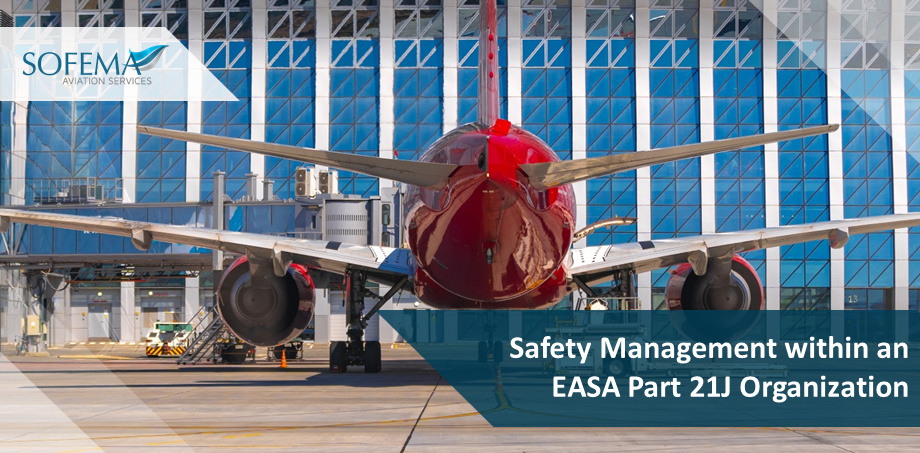Sofema Aviation Services (SAS) considers the active elements of the Safety Management System (SMS) and the Duties of the Safety Manager – Ref Regulation (EU) 2022/201
Introduction
The role of a Safety Management System (SMS) within an EASA Part 21 J – 21.A.239 Design Management System under Regulation (EU) 2022/201 is integral to ensuring aviation safety and compliance with regulatory requirements.
This regulation mandates that a design organization must establish, implement, and maintain a design management system that incorporates both a safety management element and a design assurance element. These elements are crucial for overseeing the safety and compliance of the design, changes, and repairs of aviation products, parts, and appliances.
Safety Management Element
The safety management element focuses on proactively managing safety risks associated with the organisation’s activities. Key components include:
Safety Policy and Objectives: The organisation must develop and maintain a clear safety policy, promoting a safety culture and setting specific safety objectives.
Key Safety Personnel: Appointment of key safety personnel, including a safety manager, to oversee safety management processes.
Safety Risk Management: Implementation of processes for identifying, evaluating, and managing safety hazards and risks, including mitigation and effectiveness verification.
Safety Assurance: Monitoring the organization’s safety performance, managing changes safely, and continuously improving the safety management element.
Promotion of Safety: Through training, education, and communication, to ensure all personnel are engaged in maintaining safety.
Occurrence Reporting System: Establishment of a system for reporting safety incidents to facilitate continuous safety improvement.
Primary Duties of the Safety Manager
The specific duties of the safety manager encompass a broad range of responsibilities aimed at ensuring the effective implementation and maintenance of the safety management processes. These duties are fundamental to fostering a safety culture and enhancing the overall safety performance of the design organization.
The safety manager’s specific duties include:
- Facilitating Hazard Identification
- Risk Assessment and Management
- Monitoring Implementation of Mitigation Actions
- Reporting on Safety Performance
- Maintaining Safety Management Documentation
- Ensuring Availability of Safety Training
- Providing Advice on Safety Matters
- Initiating and Following Up on Internal Investigations
- Promoting a Safety Culture
- Just Culture Advocacy
Design Assurance Element
The design assurance element ensures the design, changes, and repairs of products meet all applicable certification and environmental protection requirements. Key aspects include:
Control and Supervision of Design: A system to oversee design processes, ensuring compliance with regulatory requirements.
Independent Verification Function: A mechanism to demonstrate compliance with airworthiness, operational suitability data, and environmental protection requirements.
Accountability for Subcontracted Tasks: Procedures to ensure the acceptability of parts or tasks performed by partners or subcontractors.
Monitoring and Compliance Verification
An independent monitoring function is established to verify compliance with regulatory requirements and the adequacy of the design management system. This function is critical for identifying areas for improvement and ensuring the effectiveness of corrective actions.
Integration with Other Management Systems
If the design organization holds additional organization certificates, the design management system may be integrated with those required under the additional certificates, promoting efficiency and reducing duplication.
Role of Safety and Design Assurance Personnel
The regulation specifies roles for key personnel, including the chief of the independent monitoring function, who ensures compliance and proper audit implementation, and the safety manager, who oversees hazard identification, risk management, and safety performance reporting.
Summary
In summary, the Safety Management System within an EASA Part 21 J – 21.A.239 Design Management System is a comprehensive framework designed to ensure the safety and compliance of aviation design activities.
- It emphasizes proactive risk management, safety assurance, continuous improvement, and compliance verification, all underpinned by a strong safety culture throughout the organization.
Next Steps
Follow this link to our Library to find & Download related documents for Free.
Sofema Aviation Services and Sofema Online provide classroom, Webinar and Online training to support EASA Part 21 J Design Organisation Training & Development – For comments or questions please email team@sassofia.com
Tags:
SAS blogs, Monitoring Implementation, Mitigation Actions, Facilitating Hazard, Key Safety, Ref Regulation (EU) 2022/201, EASA Part 21J Organisation, Design management system, Safety Hazards, Safety Policy, Compliance, Just Culture, Certification, Safety Culture, safety performance, Regulatory Requirements, Safety Management, Safety Assurance, Risk Assessment




